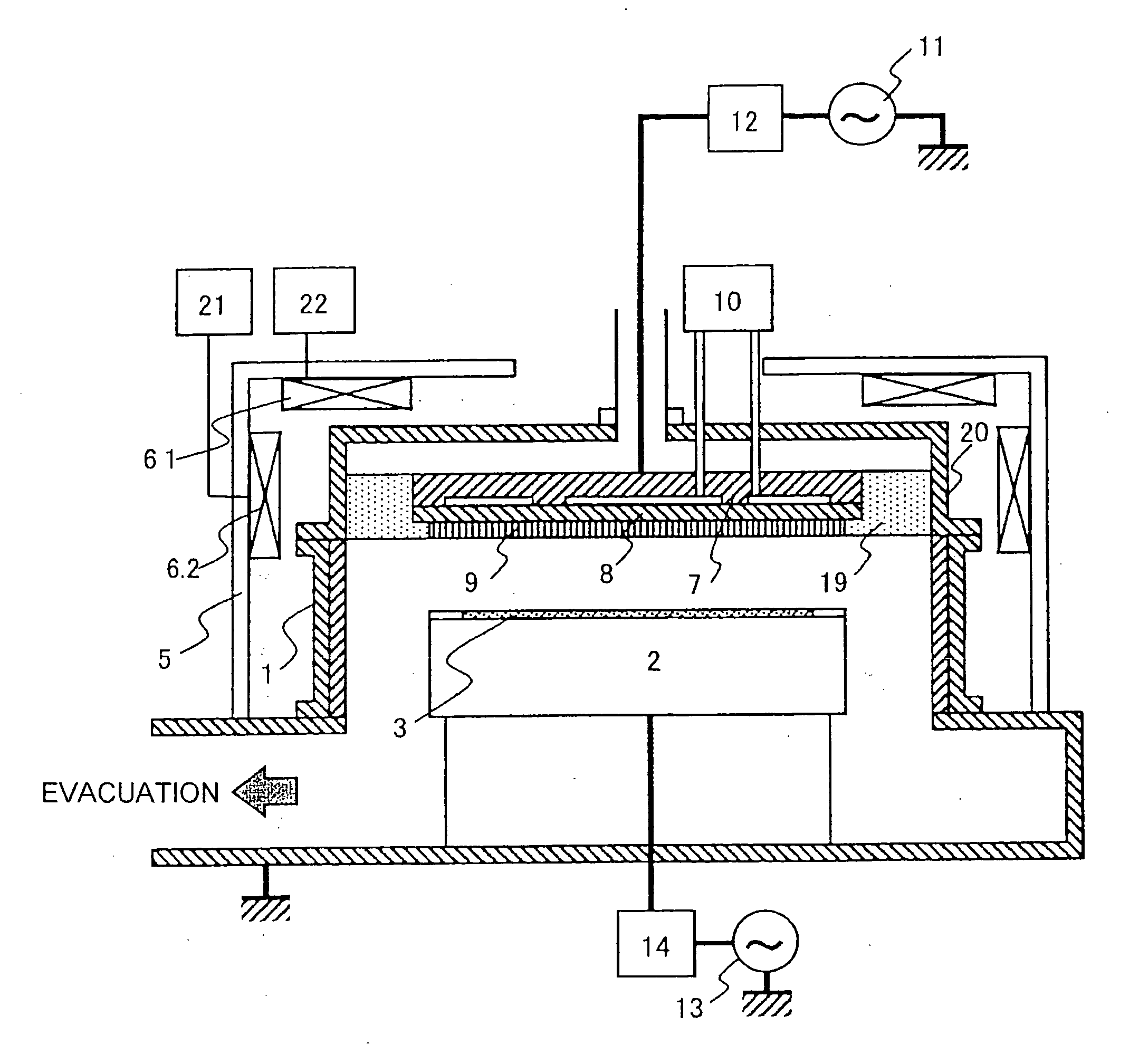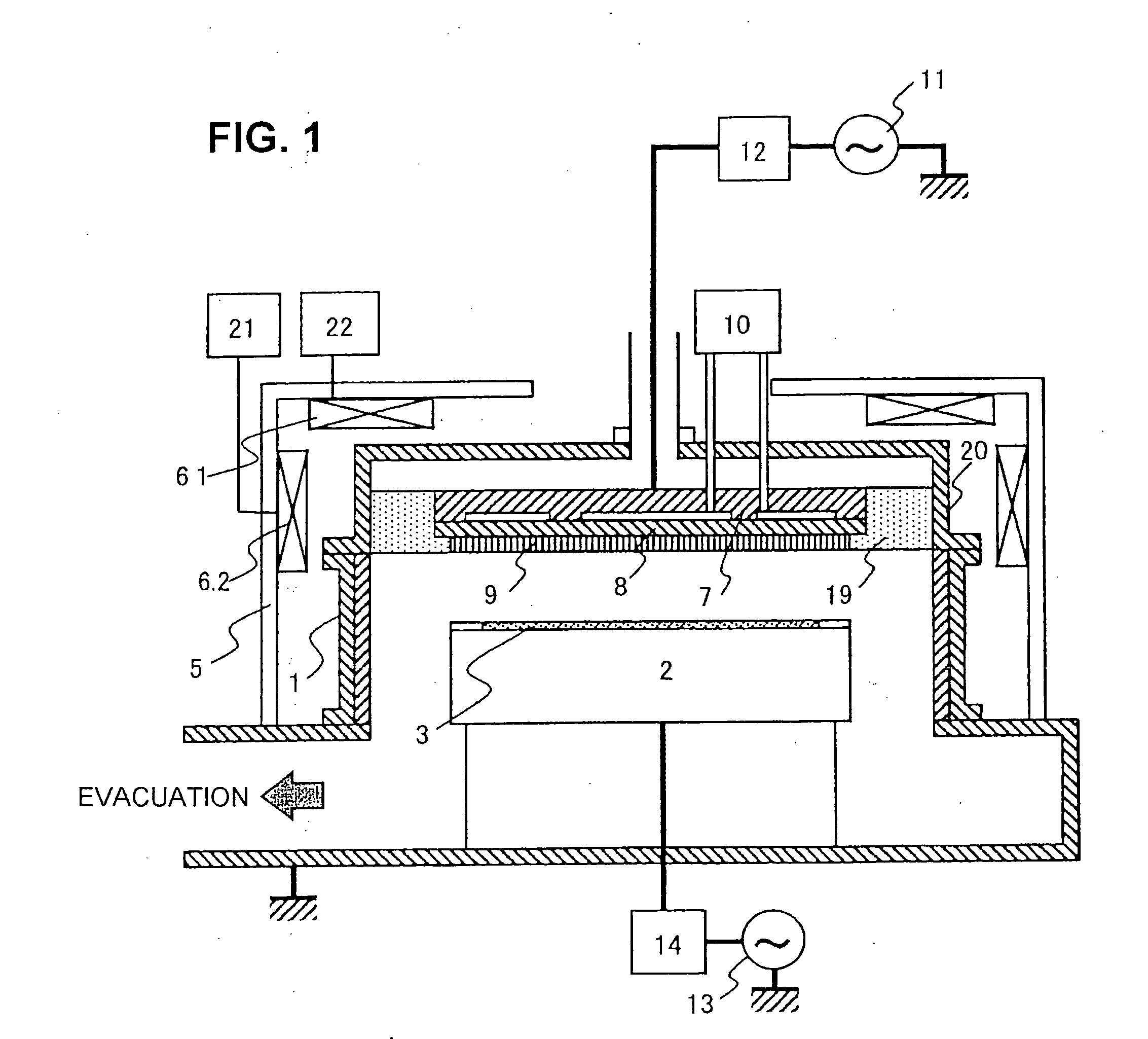Plasma processing method and plasma processing device
a processing method and plasma technology, applied in the direction of chemistry apparatus and processes, cleaning of hollow objects, electric discharge tubes, etc., can solve the problems of crucial device defects, deterioration of yield, disconnection of wires or short circuits, etc., and achieve the effect of enhancing the yield of semiconductor device fabrication
- Summary
- Abstract
- Description
- Claims
- Application Information
AI Technical Summary
Benefits of technology
Problems solved by technology
Method used
Image
Examples
embodiment 1
[0039]FIG. 1 illustrates a first embodiment of the present invention. According to the first embodiment of the present invention, the arrangement for carrying out plasma processing comprises an evacuated vacuum processing chamber 1 having a gas introduction means 10, a wafer mounting stage 2 disposed in the vacuum processing chamber 1, and a substantially round antenna 7 arranged in parallel with and facing the stage, wherein the plasma processing is carried out by applying a high frequency power to the antenna from a first high frequency power supply 11 via a first matching network 12 to thereby generate plasma by the interaction between the electromagnetic waves radiated from the antenna and the magnetic field created by the external coils 6.1 and 6.2 and a yoke 5, and applying high frequency bias to the wafer 3 to be processed from a second high frequency power supply 13 and a second matching network 14 connected to the stage 2.
[0040] The frequency of the first high frequency po...
embodiment 2
[0089]FIG. 15 illustrates a second embodiment of the present invention. In the basic arrangement of the present embodiment, explanations on the components common to embodiment 1 are omitted. In embodiment 2, the antenna portion is separated into an inner portion and an outer portion by an insulator, and a first high frequency power supply 11 and a third high frequency power supply 16 are connected to the inner antenna and the outer antenna, respectively. In the present embodiment, the method for controlling the plasma distribution differs from that of the first embodiment. That is, an out-high plasma is realized by increasing the power applied to the outer antenna. Thus, the sheath can be controlled to a convexed shape when turning the plasma on and off.
embodiment 3
[0090]FIG. 16 illustrates a third embodiment of the present invention. Explanations on the components common to the aforementioned embodiments are omitted. In the present embodiment, the antenna for generating and maintaining plasma is an induction-type antenna. A dielectric plate 19 for maintaining vacuum and transmitting induced electric field is provided on the upper portion of the vacuum processing chamber 1, and two lines of inductive antennas 7 and 21 are provided above the dielectric plate. A first high frequency power supply 11 is connected to the inner inductive antenna and a second high frequency power supply 16 is connected to the outer inductive antenna. Also according to the present embodiment, an out-high plasma is realized by increasing the power applied to the outer antenna. Thus, the sheath can be controlled to have a convexed shape when the plasma is turned on and off.
[0091] Next, FIG. 17 shows the method for reducing foreign particles based on embodiment 2 or emb...
PUM
| Property | Measurement | Unit |
|---|---|---|
| Flow rate | aaaaa | aaaaa |
| Speed | aaaaa | aaaaa |
| Speed | aaaaa | aaaaa |
Abstract
Description
Claims
Application Information
 Login to View More
Login to View More - R&D
- Intellectual Property
- Life Sciences
- Materials
- Tech Scout
- Unparalleled Data Quality
- Higher Quality Content
- 60% Fewer Hallucinations
Browse by: Latest US Patents, China's latest patents, Technical Efficacy Thesaurus, Application Domain, Technology Topic, Popular Technical Reports.
© 2025 PatSnap. All rights reserved.Legal|Privacy policy|Modern Slavery Act Transparency Statement|Sitemap|About US| Contact US: help@patsnap.com



